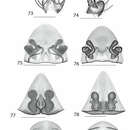Description
provided by Zookeys
Male (holotype):Color: carapace yellow-brown, with slightly darker marks medially; sternum pale yellow-brown; chelicerae pale yellow with darker infuscations anteriorly and laterally; maxillae pale yellow-brown; labium pale brown; abdomen dorsally yellow-brown with red-brown and grey markings; ventrally pale yellow-brown; legs with segments clearly annulated, annulations do not completely encircle femorae, legs darkening distally at tibiae; annulations lighter in centers giving a ‘leopard spot’ appearance. Cephalothorax: setae long and thin; 0.88 times longer than broad; fovea longitudinal, broad, very shallow. Eyes:anterior AER slightly recurved; PER recurved; PME larger than AME, PLE largest, ALE smallest; eye group width 1.54; eye diameters, AME 0.19, ALE 0.12, PME 0.24, PLE 0.26; interdistances AME-ALE 0.34, PME-PLE 0.25, ALE-PLE 0.17, AME-PME 0.05; ocular quadrangle AME-AME 0.51, PME-PME 1.2; clypeus 0.1 high. Mouthparts:chelicerae with a few stout setae medially and anteriorly; lateral boss present, smooth; promargin with 3 teeth, retromargin with 2 teeth; maxillae longer than broad, with tuft of conspicuous setae distally; labium distally rounded. Sternum: 0.9 times longer than broad, posteriorly indented. Pedipalp:femur, spination dorsal 1–2–1; retrolateral tibial apophysis with 2 processes, dorsal apophysis long, tapered and pointed at tip, ventral apophysis short, broad, rounded and flattened; retrolateral basal cymbial process present; cymbial scopulae absent, cymbium round to triangular, angled bottom right; conductor large, crescent-shaped, with two terminal processes, the anterior process is slightly curved and pointed, the posterior process is rounded; embolus very long and slender, arising from an ovoid base that tapers abruptly, beginning at 6 o’clock, terminating at 1 o’clock; MA amorphous, slightly sclerotized, with one pointed process (Figs 73–74). Legs:leg I only slightly shorter than legs II, III and IV; leg formula 3241; scopulae absent on all legs; tarsus I–IV with strong claw tufts; pr claws with c. 10 teeth, rl claws with none; spination: leg I, Fm pr 1–1–0, d 1–1–1, rl 0; Ti d 0, v 2–2–2–2–2; Mt v 2–2–2; Ti and Mt I and II with strong spines; leg II, Fm pr 0, d 1–1–1, rl 0–1–1; Ti v 2–2–2–2–2; Mt v 2–2–2; leg III, Fm pr 0, d 1–1–1, rl 0–1–1; Ti 0; Mt 0; leg IV, Fm pr 0, d 1–1–1, rl 0; Ti 0; Mt 0. Abdomen:terminal setal tufts present.Dimensions:Total length 5.15. Cephalothorax length 2.75, width 3.12. Sternum length 1.47, width 1.63. Abdomen length 2.49, width 2.06. Pedipalp: Fm 0.79, Pt 0.41, Ti 0.38, Ta 0.77, (total) 2.35. Leg I: Fm 3.49, Pt 1.32, Ti 2.89, Mt 2.62, Ta 1.43, (total) 11.75. Leg II: Fm 4.28, Pt 1.28, Ti 3.45, Mt 2.79, Ta 1.63, (total) 13.43. Leg III: Fm 4.22, Pt 1.25, Ti 3.59, Mt 3.09, Ta 1.49, (total) 13.64. Leg IV: Fm 4.11, Pt 1.09, Ti 3.39, Mt 3.22, Ta 1.49, (total) 13.30.
Female(paratype):Color: carapace yellow-brown, with slightly darker marks medially; sternum pale yellow-brown; chelicerae pale yellow with darker infuscations anteriorly and laterally; maxillae pale yellow-brown; labium pale brown; abdomen dorsally yellow-brown with darker markings; ventrally pale yellow-brown; legs with all segments clearly annulated. Cephalothorax:setae long and thin; 0.89 times longer than broad; fovea longitudinal, broad, very shallow. Eyes:AER slightly recurved; PER recurved; PME larger than AME, PLE largest, ALE smallest; eye group width 2.09; eye diameters, AME 0.22, ALE 0.14, PME 0.25, PLE 0.31; interdistances AME-ALE 0.57, PME-PLE 0.37, ALE-PLE 0.12, AME-PME 0.08; ocular quadrangle AME-AME 0.66, PME-PME 1.65; clypeus 0.11 high. Mouthparts:chelicerae with a few stout setae medially and anteriorly; lateral boss present, smooth; promargin with 3 teeth, retromargin with 2 teeth; maxillae longer thanbroad, with tuft of conspicuous setae distally; labium distally rounded. Sternum:0.89 times longer than broad, posteriorly indented. Pedipalp:tarsus slightly swollen, claw present, without teeth. Legs:leg I only slightly shorter than legs II, III and IV; leg formula 2341; scopulae absent on all legs; tarsus I–IV with strong claw tufts; pr claws with c. 10 teeth, rl claws with none; spination: leg I, Fm pr 1–1–0, d 1–1–1, rl 0; Ti d 0, v 2–2–2–2–2; Mt v 2–2–2; Ti and Mt I and II with strong spines; leg II, Fm pr 0, d 1–1–1, rl 0; Ti v 2–2–2–2–2; Mt v 2–2–2; leg III, Fm pr 0, d 1–1–1, rl 0; Ti 0; Mt 0; leg IV, Fm pr 0–0–1, d 1–1–1, rl 0; Ti 0; Mt 0. Abdomen:terminal setal tufts present. Epigyne:lateral lobes fused, copulatory openings located in center of plate, large epigynal pockets present; internally, ducts coiling 4–5 times leading to small, oblong, ovoid spermathecae, fertilization ducts located posteriorly, posterodorsal fold absent (Figs 75–76).Dimensions:Total length 10.28. Cephalothorax length 3.74, width 4.21. Sternum length 1.99, width 2.23. Abdomen length 6.39, width 5.14. Pedipalp: Fm 0.89, Pt 0.63, Ti 0.65, Ta 0.85, (total) 3.08. Leg I: Fm 3.83, Pt 1.61, Ti 3.39, Mt 2.37, Ta 1.32, (total) 12.52. Leg II: Fm 4.79, Pt 1.89, Ti 3.82, Mt 2.75, Ta 1.37, (total) 14.62. Leg III: Fm 4.98, Pt 1.69, Ti 3.89, Mt 2.53, Ta 1.35, (total) 14.44. Leg IV: Fm 4.75, Pt 1.42, Ti 3.61, Mt 3.11, Ta 1.38, (total) 14.27.
- license
- cc-by-3.0
- copyright
- Sarah C. Crews, Mark S. Harvey
- bibliographic citation
- Crews S, Harvey M (2011) The spider family Selenopidae (Arachnida, Araneae) in Australasia and the Oriental Region ZooKeys 99: 1–104
- author
- Sarah C. Crews
- author
- Mark S. Harvey

